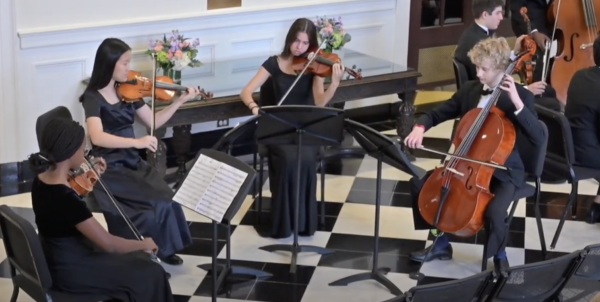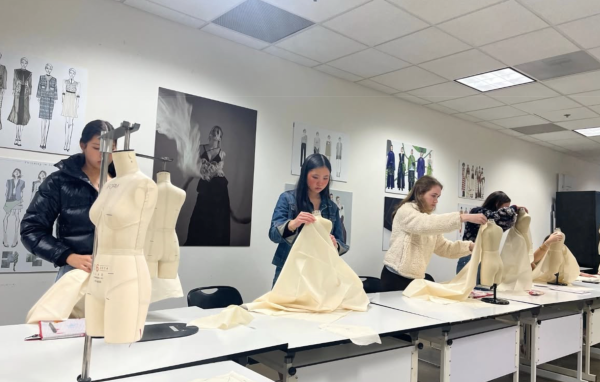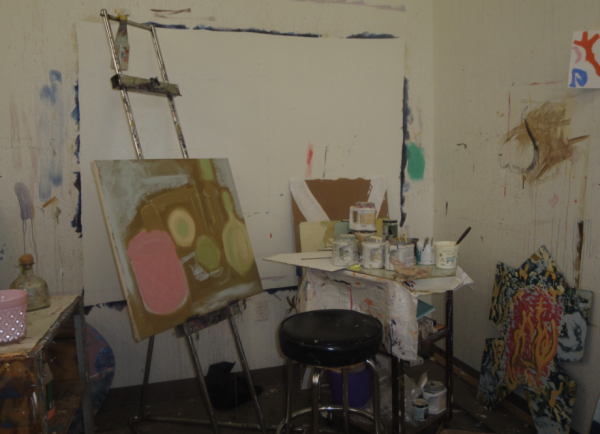Symphonies in the spring: Westminster’s orchestra concert
Each year, on a cool spring evening, the Westminster symphony orchestra concert brings together people of all ages for a riveting performance of music in Pressly Hall’s McCain Chapel. The concert is a compilation of different pieces from various genres performed by Westminster’s Lower, Middle, and Upper School students.
The concert always begins with the Lower School orchestras, each young pupil dressed in their uniform and intensely focused on their technique.
“I love how the concert always starts off with the littlest ones,” said sophomore Anastasia Waid. “Watching them play always reminds me of when I was in the presto orchestra, and it’s always so cool to see how much the kids grow and improve over the years.”
After the Lower Schoolers finish, bow, and shuffle off, the Middle Schoolers take the stage. Their concert master tunes the orchestra, they play, and then they leave the stage. The audience applauds, parents smiling proudly as their children finish playing. As the lights dim, however, the audience quiets quickly in anticipation of the most eagerly awaited part of the concert: the symphony orchestra performance.
The Upper School symphony orchestra is a combination of selected wind, brass, and percussion players and the Upper School orchestra. The symphony orchestra, conducted by Upper School performing arts faculty Linda Cherniavsky and Scott Stewart, is a favorite performance of many students.
“When I was in middle school, my favorite part of the spring concert was always getting to watch the high schoolers play,” said senior violinist Connor Li. “I always thought they looked so cool in their tuxes and dresses, and now I get to look cool playing in mine.”
The symphony orchestra traditionally performs a piece from modern film, as well as several classical pieces. The film piece is always accompanied by a montage of scenes from the movie, so the orchestra appears to be performing the soundtrack as the movie plays.
“Film music is very popular and is a way that allows people to come into contact with the symphonic sound,” said Cherniavsky. “Have you ever watched a movie scene without sound and then again with? Music affects completely the impact of the visual images on the screen.”
This year’s repertoire includes music from the Indiana Jones movie, Raiders of the Lost Ark, as well as Beethoven’s Egmont Overture, as a celebration of the renowned composer’s 250th birthday. Due to the COVID-19 pandemic, however, this year’s music has been especially difficult for the Upper School musicians to master. While playing socially distanced might not seem like a daunting obstacle, for an orchestra of 43 people playing in an echoey space, it makes performing together all the more difficult.
“The spacing of the orchestra and the band has made it much harder to learn the music,” said Waid. “That, combined with the acoustic complications of McCain, has made it really hard for us to sound cohesive and unified. The reverb and the echoes of our sound off the walls cause the people seated at the edge of the room to fall behind, and eventually our whole sound falls apart because people are playing too fast, too slow, or just get lost.”
The performers are not the only ones who have to adapt to the new circumstances. In fact, the conductors have had to change altogether their methods of conducting the symphony orchestra.
“With the winds and percussion on stage and the orchestra on the floor, it creates a challenge in how I conduct my students,” said Cherniavsky.
With the symphony orchestra surrounding the conductor, Cherniavsky and Stewart must turn constantly as they conduct in order to be able to cue all sections of the symphony orchestra.
Despite the obstacles they faced, the orchestra worked hard to get ready for its performance. During their sixth period class, PARTS, and even early on Wednesday mornings, the symphony orchestra could be heard rehearsing their pieces in preparation for the concert.
“I feel like we’re ready for this,” said Li before the performance. “Our music is challenging and it’s not easy to play socially distanced, but I’m confident that we can do it. We’ve been working really hard during class, and recently we’ve been sounding a lot better.”
Due to the pandemic, this year’s symphony orchestra concert was not performed live. Instead, the performance was recorded, edited, and released on March 15 on the WCAT YouTube channel. Listeners can tune in to hear a captivating performance!



